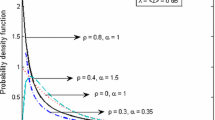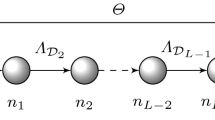Abstract
Wireless channels are subject to short term fading and shadowing. Such shadowed fading channels are described using a Nakagami-lognormal process, with the Nakagami-m (short term fading) and lognormal distributions (shadowing). This approach does not result in a closed form solution for the density function of the signal-to-noise ratio (SNR) making wireless systems analysis difficult. It was suggested that a gamma or an inverse Gaussian distribution can be used in place of the lognormal distribution providing an analytical framework. The match of these two distributions to the lognormal was less than ideal. Invoking shadowing as multiplicative process, the distribution of the product of N gamma variables is proposed in place of the lognormal pdf resulting in the Nakagami-N-gamma model. It is shown that this model leads to simple solutions to the density and distribution functions as well as error rates for coherent phase shift keying modems. The outage probabilities and error rates based on the Nakagami-lognormal (NL) and Nakagami-N-gamma (NNG) models were compared. Results showed excellent match at levels of shadowing generally observed in wireless systems. While values of N as low as 3 was sufficient for low values of m and weak to moderate shadowing, values of N in the range of 7–9 provided better match for higher levels of shadowing and higher values of m. By varying N, it is also possible to get the NNG pdf to move closer to the NL pdf making the new model an ideal one for the shadowed fading channels with its flexibility and availability of analytical expressions.
Similar content being viewed by others
References
Nakagami M. (1960) The m-distribution—A general formula of intensity distribution of rapid fading. In: Hoffman W. C. (eds) Statistical methods in radio wave propagation. Pergamon Press, Elmsford, NY
Suzuki H. (1975) A statistical model for urban radio propagation. IEEE Transactions on Communications 25(7): 673–679
Coulson A. J., Williamson A. G., Vaughan R. G. (1998) A statistical basis for lognormal shadowing effects in multipath fading channels. IEEE Transactions on Communications 46(4): 494–502
Abdi A., Kaveh M. K. (1998) Distribution: An approximate substitute for Rayleigh-lognormal distribution in fading-shadowing wireless channels. Electronics Letters 34: 851–852
Shankar P. M. (2004) Error rates in generalized shadowed fading channels. Wireless Personal Communication 28: 233–238
Bithas P. S., Sagias N. C., Mathiopoulos P. T., Karagiannidis G. K., Rontogiannis A. A. (2006) On the performance analysis of digital communications over generalized-Kfading channels. IEEE Communications Letters 10: 353–355
Karmeshu R. A. (2007) On the efficacy of Rayleigh-inverse Gaussian distribution over K-distribution for wireless fading channels. Wireless Communications Mobile Computer 7: 1–7
Laourine A., Alouini M.-S., Affes S., Stéphenne A. (2009) On the performance analysis of composite multipath/shadowing channels using the G-distribution. IEEE Transactions on Communications 57(4): 1162–1170
Andersen, J. B. (2002). Statistical distributions in mobile communications using multiple scattering. In Proceedings 27th URSI general assembly. Netherlands: Maastricht.
Erceg V., Fortune S. J., Ling J., Rustako A. J. Jr., Valenzuela R. A. (1997) Comparisons of a computer-based propagation prediction tool with experimental data collected in urban microcellular environments. IEEE Journal Selected areas in Communications 15(4): 677–684
Salo J., El-Sallabi H. M., Vainikainen P. (2006) The distribution of the product of independent Rayleigh random variables. IEEE Transactions on Antennas and Propagation 54: 639–643
Clark J. R., Karp S. (1970) Approximations for lognormally fading optical signals. Proceedings IEEE 58: 1964–1965
Gradshteyn I. S., Ryzhik I. M. (1994) Table of integrals, series, and products (5th ed.). Academic, San Diego, CA
Asplund, H., Molisch, A. F., Steinbauer, M. & Mehta, N. B. (2002). Clustering of scatterers in mobile radio channels—Evaluation and modeling in the COST259 directional channel model. In Proceedings IEEE ICC (pp. 901–905). New York.
Papoulis A. (2002) Probability, random variables and stochastic processes (4th ed.). McGraw-Hill, New York
Mathai A. M. (1993) A handbook of generalized special functions for statistical and physical sciences. Oxford University Press, Oxford, UK, pp 82–83
Karagiannidis G. K., Tsiftsis T. A., Mullik R. K. (2006) Bounds for multihop relayed communications in Nakagami–m fading. IEEE Transactions on Communications 54(1): 18–22
Shankar P. M. (2006) Performance analysis of diversity combining algorithms in shadowed fading channels. Wireless Personal Communication 37: 61–72
Molisch A. (2005) Wireless communications. John Wiley & Sons, Hoboken, N. J., USA
Nee R., Prasad R. (2000) OFDM for wireless multimedia communications. Artech House, Boston, MA
Ma, X., Kobayashi, H., & Schwartz, S. C. (2003). In Proceedings of the 14th IEEE international symposium on personal, indoor and mobile radio Communication (pp. 2239–2243).
Hou, L., Huijie, L., & Xiaokang, L. (2007). BER calculation of an OFDM system with phase nonlinearity. In Proceedings international symposium on intelligent signal processing and communication systems (pp. 633–636). China: Xiamen
Santhanathan K., Tellambura C. (2001) Probability of error calculations of OFDM systems with frequency offset. IEEE Transactions Communications 49: 1884–1887
Weeraddana P. C., Rajatheva N., Minn H. (2009) Probability of error analysis of BPSK OFDM systems with random residual frequency offset. IEEE Transactions Communications 57: 106–116
Le K. N. (2010) BER of OFDM in Rayleigh fading environments with selective diversity. Wireless Communications and Mobile Computing 10: 306–311
Author information
Authors and Affiliations
Corresponding author
Rights and permissions
About this article
Cite this article
Shankar, P.M. A Nakagami-N-gamma Model for Shadowed Fading Channels. Wireless Pers Commun 64, 665–680 (2012). https://doi.org/10.1007/s11277-010-0211-5
Published:
Issue Date:
DOI: https://doi.org/10.1007/s11277-010-0211-5




